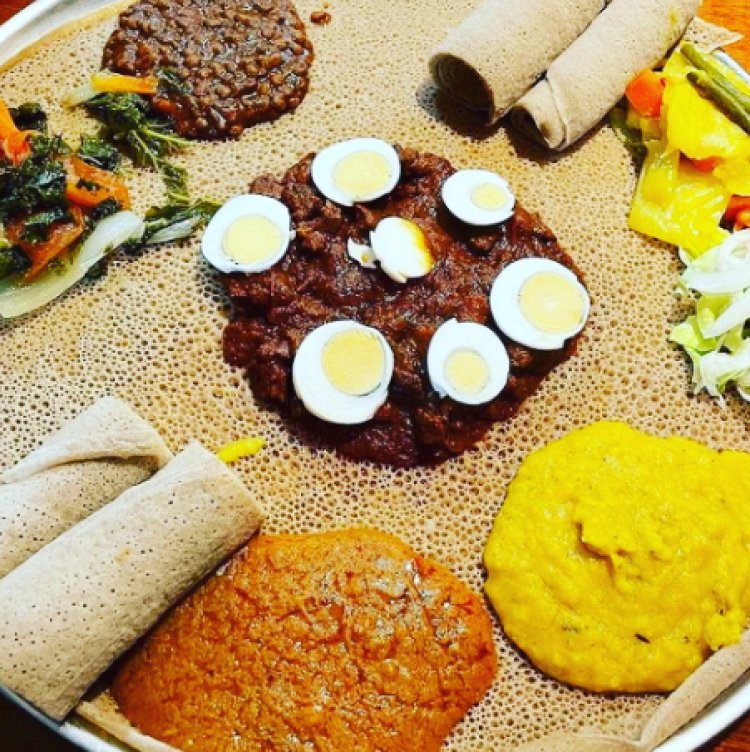How to Prepare Authentic Injera
In Ethiopia and Eritrea, injera is a common dish consumed every day in almost all homes. Injera is used as a serving base for scooping a variety of stews, meat, salads, and vegetables like Doro wat, gomen wat, and much more.

Injera is a crepe-like sour fermented pancake-like flatbread that has a distinctive porous and slightly spongy texture.
Teff flour and water are the only two components required to make injera traditionally. Teff is a traditional cereal crop from the Ethiopian Highlands that is crushed into flour. Injera comes in a variety of colors because different types of teff seeds—white, red, brown, or mixed—are used to produce them. Grains such as wheat, barley, corn, or rice flour are sometimes used to replace part or all of the teff content. However, teff is the ideal grain for injera due to its color, flavor, and aroma as well as the fact that it is gluten-free.
How to eat injera

Tear little pieces of injera with your hand and use the pieces to scoop the stews and salads for eating. When the stews and salads are finished, the injera that was underneath them is also eaten because it absorbed the juices and flavors of the food.
Tips for preparing injera
If you've never made injera before, try using a mixture of teff and barley or wheat instead of all teff because dealing with teff alone is challenging.
Teff alone or in large quantities will not result in the spongy, fluffy injera; wheat, barley, and a small amount of teff is used to achieve fluffiness.
If the injera batter turns out so runny, add some more teff flour until you reach the desired consistency then stir well until the teff flour is completely dissolved in the mixture. Leave it to ferment for an extra day before cooking.
You will notice little bubbles on your batter after fermentation. If it doesn't, add a teaspoon of baking soda, stir well, and let sit for 10 minutes. The baking soda will enable the batter to develop batter.
Ingredients
2 cups teff flour, or substitute a portion with some barley/wheat flour
3 cups water
Procedure
Combine the flour, water, and yeast in a sizable mixing bowl (yeast is optional).
Place some plastic wrap loosely over the bowl, and let the mixture to sit for 4-5 days at room temperature (the longer it ferments, the deeper the flavor). If the mixture is getting too dry, you might need to add a little more water, depending on the type of flour used.
Depending on the humidity, a layer of aerobic yeast will have grown on top of the bubbly, extremely dark mixture. Aerobic yeast is a typical result of fermentation. However, if your batter starts to grow mold, it must be disposed.
Pour off the aerobic yeast and as much of the liquid as possible to obtain a clay-like batter then stir well.

Boil a cup of water in a small saucepan, then stir in half a cup of the injera batter, whisking constantly until it is thickened.
Once thickened, remove from the heat and stir the cooked batter back into the original fermented batter. The batter should have a sweet-soured nutty smell.

Add some water to the batter to thin it out to the consistency of crepe batter.
Heat a non-stick pan over medium heat then lightly spray it with some oil (using oil is optional depending on the quality of your pan)
Spread the injera batter evenly across the bottom of the pan not as thin as crepes but not as thick as traditional pancakes.
Allow the injera to bubble and let the bubbles pop, once the bubbles have popped, place a lid on top of the pan and turn off the heat. Allow the injera steam to cook for a couple of minutes until cooked through.
Do not overcook the injera or they will become gummy and soggy.
Remove the injera from the pan and repeat the procedure with the remaining batter.

Conclusion
Injera can be found in grocery shops and eateries that specialize in Ethiopian and Eritrean cuisine due to the fame it has accrued over time as an authentic traditional meal from those two countries.
Depending on the type of teff you used and the mixture of flours, the injera can have a wide range of textures and colors. Wheat and barley flours, which contain gluten, produce a very different texture than when you use teff alone.


























